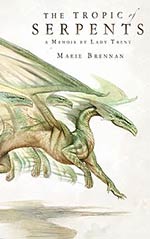
![]() Rabindranauth@DDR
Rabindranauth@DDR
11/17/2014
![]()
The moderately scandalous and questionably treasonous actions of Isabelle Camherst continue in The Tropic of Serpents, the second of Marie Brennan's Memoirs of Lady Trent. By turns more inventive and explosive than the first, but also a bit slower.
Three years after the infamous Vystrana expedition, Mrs. Camherst has had enough of staying home and exploring the revelations of the expedition. It's with almost no regret that she joins the new expedition Lord Hilford is organizing for the pseudo-African, war ravaged continent of Eriga. But what awaits her in the Green Hell is a life infinitely more dangerous than the previous expedition. With only her Lord Hilford's man, Tom Wilker, and her own young ward, Hilford's granddaughter, along for the ride, it's Isabella's most harrowing adventure to date as she explores the dragons that dwell beyond the Tropic of Serpents.
An altogether much more entertaining and yet very different tale from the first memoir, The Tropic of Serpents was an incredibly quick read, due to its relatively fast paced nature and also to its short length. It's much more action packed than A Natural History of Dragons was, but at the same time it lacks the mystery and suspense that the previous tale has. Instead, Marie Brennan weaves a plot of intrigue and political unrest as Mrs. Camherst and company inevitably get dragged into history-changing events on the ground in Eriga.
Though in many ways this is a much more explosive, danger-fraught outing than the events in the previous expedition, overall I enjoyed that tale more than I did this one. The Tropic of Serpents is overall a less mysterious tale with a deeper focus on worldbuilding. As Mrs. Camherst sets out to explore the savannah snakes, swamp-wryms and tree snakes of the surrounding area, it becomes very much a tale of the team mostly struggling to conduct their business whiles maintaining respect for the local cultures, whilst at the same time attempting to avoid being dragged into the hotbed of local politics but nevertheless being subject to a fair amount of intrigue. And that's before they enter the Green Hell, the extremely dangerous jungle where everything from dragons to venomous fauna to rampaging diseases can kill you. And that's not even touching the extreme heat and the brutal lifestyle of the natives. It all makes for a fairly engaging survival tale, but for the most part it had its ups and downs for me.
I found myself mostly bored during the section of the book where the team was forced to live among the Mouleen for nearly a year, following their way of life and learning their customs before really getting to explore the dragons that inhabit the area. It's a section of the book that delves very deeply into the native people, and for the most part I just didn't find myself as engaged with it. It was, however, a necessary part of the evolution of Mrs. Camherst, her trials and tribulations in the Green Hell allowing her to deal on a psychological level with the doubts she has of herself, concerning her defiance of Society for her perceived place as a woman, and her practical abandonment of her son. It also served as a primer for the politically charged ending, so as much as I didn't enjoy that section of the tale much, I do appreciate why it had to be written.
In this book, we see even less of dragons than we did in the previous, but those there are prove much more interesting. The swamp-wyrm has a life cycle very, very different from the rock-wyrms of Vystrana, and the way it coexists not only with the natural ecosystem but with the inhabitants of the Green Hell altogether makes it a fascinating exercise of imagination I couldn't help but enjoy. Come to think of it, exploring the way those elements interact with each other and watching it come together was the most interesting part of the novel for me.
Marie Brennan also makes a little trade-off in exchange for packing so much worldbuilding and political intrigue into a novel as short as this one; she drastically reduces the social commentary of the oppressed woman in this book. The theme still exists in copious amounts throughout the novel, but in much less heavy handed ways than it did in the first. In this case, we see it manifest mostly during the cleansing ceremony the Moulish force her to undergo, and also during the purification rituals at the start, where women are basically forced to live in comfortable isolation for seven days because of their menstrual cycles. It's a lot more subtle, but it's also not as powerful as it was in A Natural History of Dragons.
Overall, it's a much more exciting book than it's predecessor, but it just didn't capture me in the same way that the previous one did. In this case, that's really a difference I get by splitting hairs. The humor I enjoyed previously was rarely here, as you'd expect from a main character staring death in the face everyday, but instead we have a tale of incredible political depth that the expedition eventually has explosive consequences for. By the end, every bit a fascinating read as the first Memoir of Lady Trent was. And now the wait begins for the next adventure that made Lady Trent the renowned dragon expert that she is, The Voyage of the Basilisk!
http://drunkendragonreviews.wordpress.com/